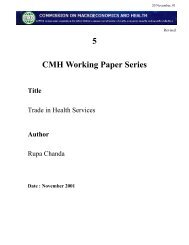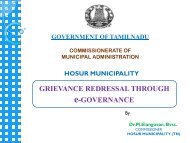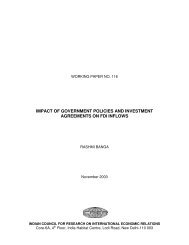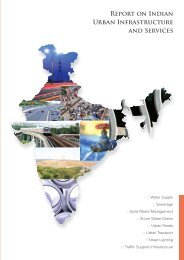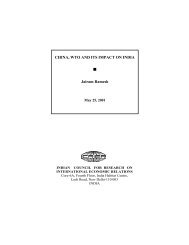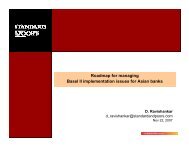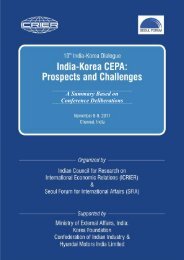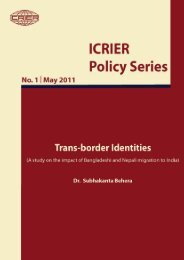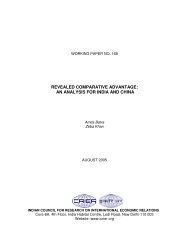Asia's Arc of Advantage - icrier
Asia's Arc of Advantage - icrier
Asia's Arc of Advantage - icrier
You also want an ePaper? Increase the reach of your titles
YUMPU automatically turns print PDFs into web optimized ePapers that Google loves.
agreements to maintain peace and tranquility along the disputed border signed in 1993 and<br />
1996 as well as a 2005 protocol on military CBMs, China’s behaviour has not been constrained. 34<br />
It is now apparently demanding further accords on military CBMs and, rather disingenuously,<br />
has suggested that China wishes to speed up the resolution <strong>of</strong> the boundary dispute. It can<br />
hardly promote prospects for that by surreptitious encroachment into Indian territories.<br />
India has so far insulated deeper engagement with China in various spheres from the boundary<br />
dispute. This benign and trusting approach is now in question, given the outcry in the Indian<br />
public and media against the Chinese incursion. During the visit <strong>of</strong> China’s new Prime Minister<br />
Li Keqiang to New Delhi on May 20, 2013, his Indian counterpart Manmohan Singh made it<br />
clear that “the basis for continued growth and expansion <strong>of</strong> our ties is peace and tranquility<br />
on our borders.” 35 Going forward, it will be difficult for New Delhi to countenance further<br />
provocations or attempts to alter the status quo by China without adverse repercussions on<br />
its wider relations with China. It may also reorient approaches towards boundary settlement<br />
negotiations by demanding the “clarification” <strong>of</strong> the Line <strong>of</strong> Actual Control (LAC) and seek<br />
greater transparency on China’s plans to build a series <strong>of</strong> dams on the Brahmaputra River.<br />
India has stepped up its strategic partnership with ASEAN in recent months. India and ASEAN<br />
have committed to “work together more purposefully for the evolution <strong>of</strong> an open, balanced,<br />
inclusive and transparent regional architecture.” 36 India has also pledged to intensify its<br />
engagement with ASEAN “for maritime security and safety, for freedom <strong>of</strong> navigation and for<br />
peaceful settlement <strong>of</strong> maritime disputes in accordance with international law.” 37<br />
Further strengthening <strong>of</strong> maritime security ties between India and Japan is likely to be another<br />
consequence <strong>of</strong> China’s regional assertiveness. And India may also move on strengthening<br />
its defence co-operation framework with the US and lift its current restraint on multilateral<br />
security activities/exercises in the Indo-Pacific region.<br />
Signalling this new trend, Indian Prime Minister Manmohan Singh outlined India’s approach<br />
to maritime security issues in the Asia-Pacific and co-operation between India and Japan on<br />
May 24, 2013, in the following terms:<br />
“Both India and Japan are important maritime nations. Therefore, safety and security <strong>of</strong><br />
the sea lanes <strong>of</strong> communication, especially in the Indian and Pacific oceans, is vital for<br />
both countries. India supports freedom <strong>of</strong> navigation and un-impeded lawful commerce<br />
in international waters, and the right <strong>of</strong> passage in accordance with accepted principles<br />
<strong>of</strong> international law. We believe that where disputes exist, these should be peacefully<br />
resolved by concerned parties through negotiations. This is essential for peace and<br />
stability in our region.” 38<br />
34 Indrani Bagchi, “Chinese Incursion Violates 2005 Pact,” Times <strong>of</strong> India, May 03, 2013, available at http://<br />
articles.times<strong>of</strong>india.indiatimes.com/2013-05-03/india/39008379_1_two-sides-protocol-border-personnel.<br />
35 “PM sends tough signal on Ladakh incursion to Li,” Times <strong>of</strong> India, May 21, 2013, available at http://articles.<br />
times<strong>of</strong>india.indiatimes.com/2013-05-21/india/39418226_1_depsang-border-mechanism-incursion.<br />
36 “India expands strategic ties with Asean,” Times <strong>of</strong> India, December 21, 2012, available at http://articles.<br />
times<strong>of</strong>india.indiatimes.com/2012-12-21/india/35952491_1_india-asean-relationship-india-and-aseannations-asean-community.<br />
37 Ibid.<br />
38 Dr. Manmohan Singh, “PM’s Interview with the Japanese Media,” Prime Minister’s Office, Government <strong>of</strong><br />
India, May 26, 2013, available at http://pmindia.gov.in/press-details.php?nodeid=1623.<br />
Regional Dimensions <strong>of</strong> South China Sea Issues | 55




